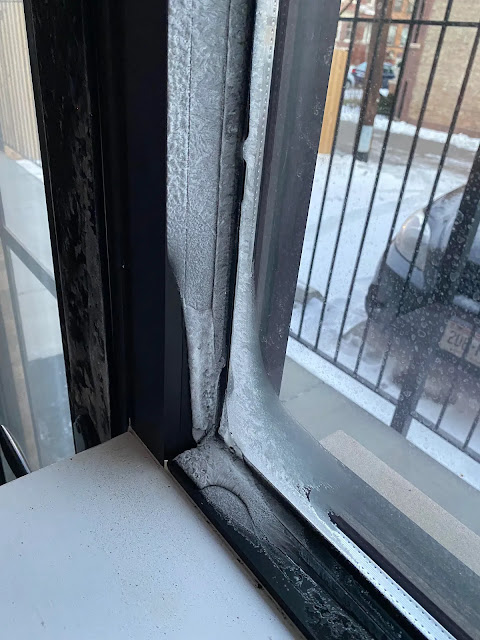Why Windows Ice Up on the Inside & How to Stop it
Ice & Windows
If you live in a house with original aluminum or single pane windows, then your house was built prior to 1970 when double pane windows became more widespread. In colder climate zones, a common problem that arises during the cold winter months is ice forming on the inside of their windows, on the actual glass. Other typical issues people experience are. the frames “sweating” (which is related to this topic), being hard to open and drafty (which is also connected to the topic of icing up).
Does your window look something like this…
 |
| Ice on old wood single pane window |
Why Does This Occur?
Ice comes from frozen moisture/water vapor so then the question turns into, why is there moisture on the inside of my windows? It stems from interior humidity (aka water vapor in the air) trying to escape to the outside of your home. It finds the path of least resistance which would be your windows or through the glazing. When it hits the window frames and/or glass, the water vapor condenses and if the glass/frame is cold enough (below freezing temp.) then it will turn into ice. The only way for this to occur is with poorly insulated windows such as old aluminum or single pane wood or aluminum. It also requires a decent amount of inside humidity levels, but the biggest factor is the window.
Sidenote: A lot of people with new energy efficient windows experience interior surface condensation which traces the root problem back to super high humidity levels within the living space.
Old Aluminum Frames
You may know this already but aluminum is a very conductive material, as are all metals. Conduction means "the process by which heat or electricity is directly transmitted through a substance." In relation to windows, it means when the weather is really hot outside the frame (aluminum in this case) heats ups from the sun. Likewise, when it's cold outside, metal tends to be the coldest material to touch... (Remember those childhood movies where a kid gets dared to put their tongue on a flag pole when its snowing outside?) So imagine how hot or cold your old aluminum windows get during the extreme months. All of that heat, or all of the freezing cold temperatures transfers from the outside of the window frame right to the inside which happens to be inside your house. Combine that with a drafty window and no energy coating on the glass, you get a really bad window that is greatly affected by the outside temperature.
Is it Controllable?
Yes and No.
If you plan on keeping the old wood or aluminum windows, you can reduce the amount of ice (and condensation) on the windows by doing these three things: 1) Buy a dehumidifier to keep your homes relative humidity between 40-60%. 2) Ventilate as much as possible, especially when cooking things in the kitchen as well as when showering in the bathroom. The goal here is to extract the excess moisture that is created by cooking things and showering. 3) Add weather-stripping around window seals. This may not look pretty but it will help with the air infiltration around the window frames/sash's which plays a role in all of this.
 |
| How you want an energy efficient window to operate. Keep the cold out during winter and keep the heat out during summer. |
Best Solution:
The best solution is to replace your old single pane or aluminum windows with with energy efficient ones. There is a vast market out there for new windows but my best advice would be to get the most efficient windows you can afford. That means choosing the best type of Low-E (Low Emissivity) coatings for you climate zone and it may mean having triple pane glass if one can swing it. For the frame material, you can choose between vinyl, fiberglass, composite, wood, wood/clad, and aluminum. The new aluminum windows are more efficient than the old ones like we discussed earlier because they utilize a "thermal break." In simple terms, a thermal break on a window stops the conductivity from transferring from the outside of the frame to the inside of the frame. This helps tremendously with our icing and condensation issue however even with these new thermal break aluminum windows, they are not the most efficient option.
 |
| Efficient window not freezing up or condensing during a cold spell |

.JPG)


Comments
Post a Comment